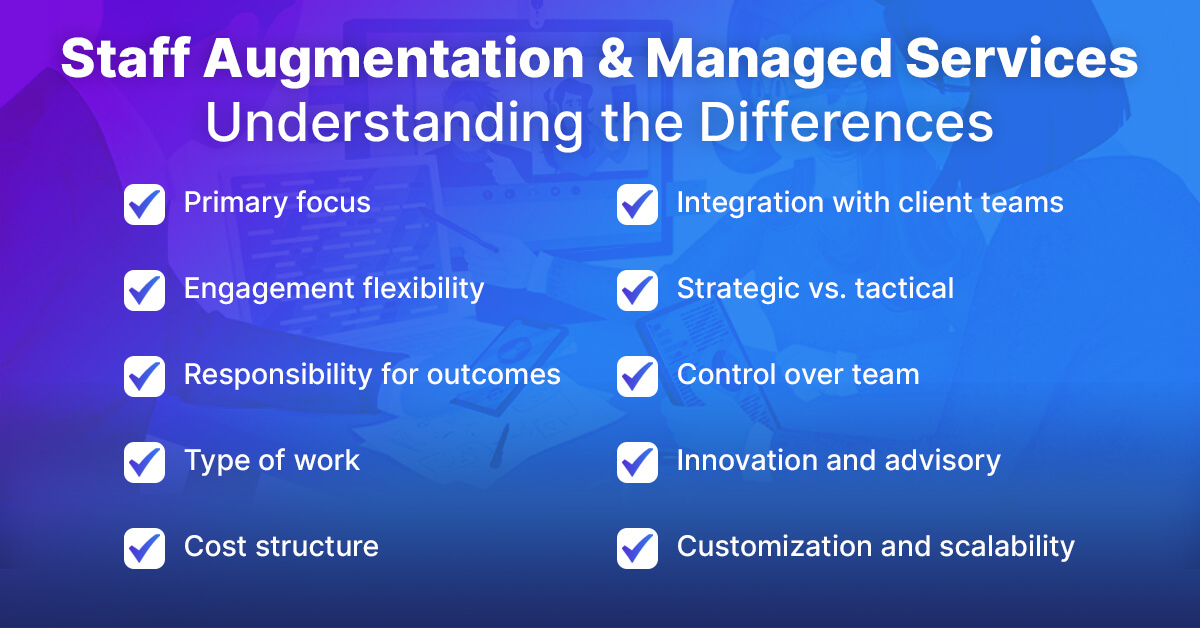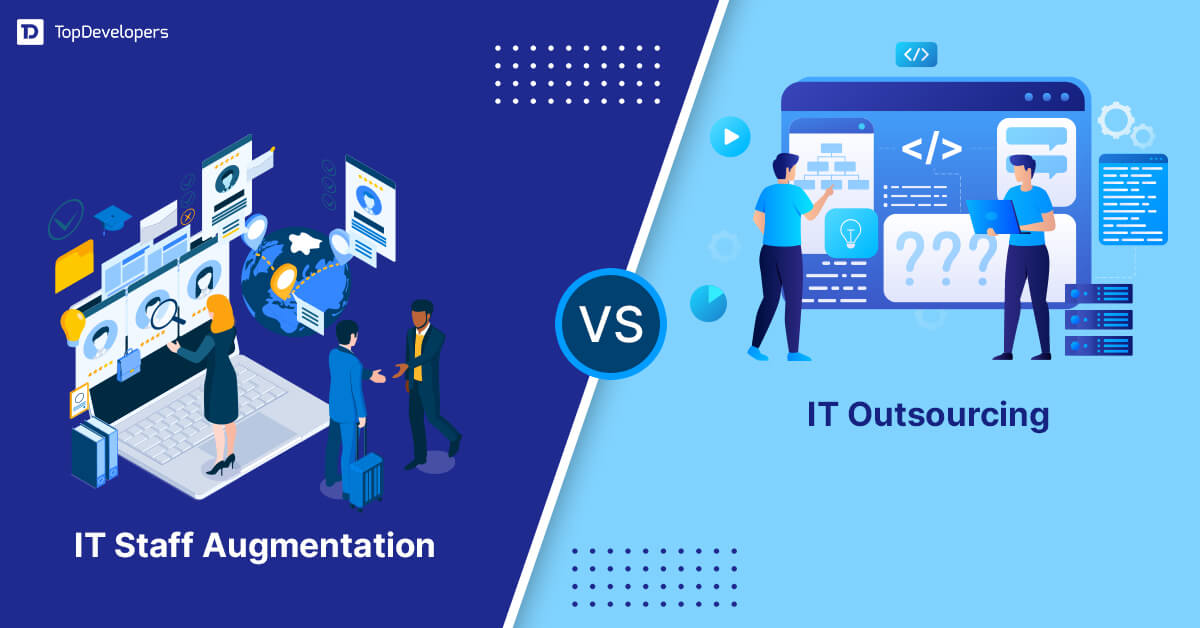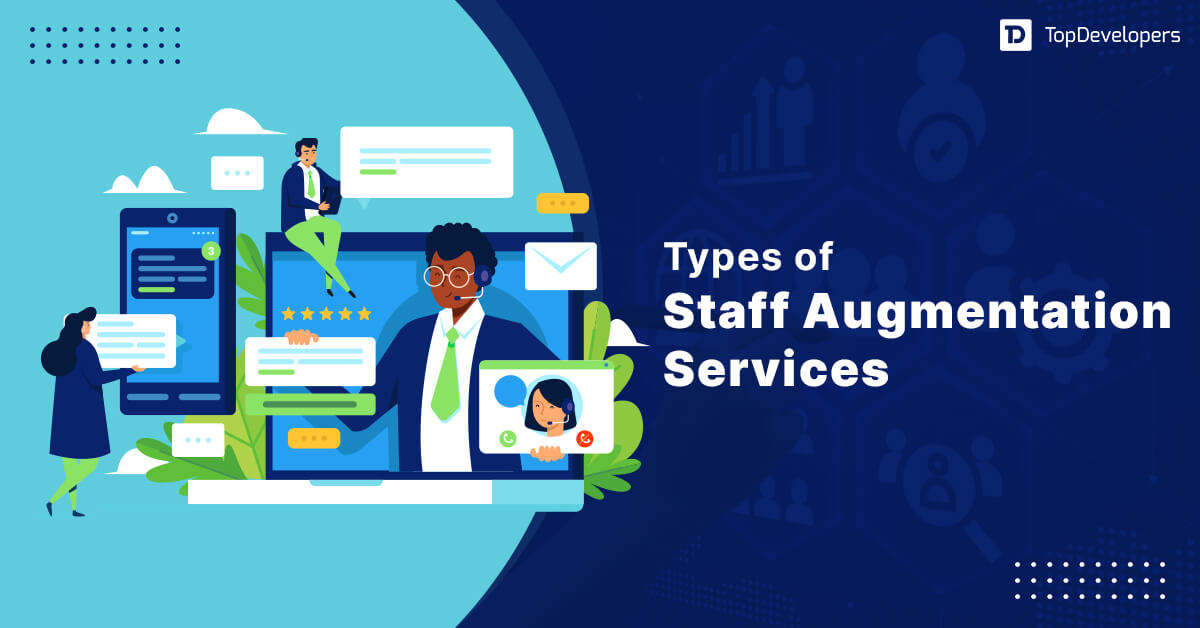
The global IT outsourcing market size, in 2022, was valued at US $565.2 billion and is likely to grow at a CAGR of 9.3% resulting in US $1416.3 billion by 2031 according to Straits Research firm. The outsourcing market for software solution development is not new. It has been flourishing ever since its inception and is likely to expand as the time comes.
As the newer tools and technologies such as Artificial Intelligence, Machine Learning, Deep Learning, the Internet of Things, Augmented/Virtual Reality, and Metaverse evolve and advance, the requirements of professional inputs to set up an IT infrastructure or meet the needs of more resources to fulfill project demands will only increase.
SMEs and large-sized enterprises leverage the benefits of outsourcing skilled resources by choosing the best IT staff augmentation companies and signing contracts for a specific project or term as per their business requirements. Here, in this guide, we will discuss the similarities, differences, and benefits of staff augmentation and managed services.
Table of Contents
- Staff Augmentation vs. Managed Services: What Are They?
- Key Differences Between Staff Augmentation and Managed Services
- A Summary Table: Staff Augmentation and Managed Services Differences
- The Benefits of Staff Augmentation Services
- The Benefits of Managed Services
- It Managed Services vs. Staff Augmentation – Which One Is Best for You?
- Want Professional Help for Your IT Projects and Management?
Staff Augmentation vs. Managed Services: What Are They?
What is staff augmentation?
Staff augmentation can be defined as a business model wherein businesses temporarily hire outside professionals to enhance their staffing capacity to finish a project of a client or their own. Enterprises have the best choice for outsourcing their IT professional help to offshore software development companies in hubs like India and USA. Staff augmentation services could be availed for any stage of software development such as feasibility, programming, QA, or maintenance.
What are managed services?
In managed service, an enterprise entrusts specific functions to third-party vendors such as data migration, cybersecurity, software development, or even data administration. Managed services operate on their own by providing an outline of project deliverables and a quote of professional service charges. Managed services, in a way, is outsourcing the entire business functions to renowned IT companies preferably at offshore locations.
Key Differences Between Staff Augmentation and Managed Services
Staff augmentation and managed services are two different approaches used to meet staffing needs and manage IT operations in the business organization. While both are intended to enhance organizational capabilities, they are different in their purpose, focus, engagement models, and results.
Let’s delve into a detailed comparison between staff augmentation and managed services:
Primary focus
Staff augmentation services are meant to focus on enhancing existing teams with specific skills or roles to meet transient needs or project requirements. It allows business owners to scale their workforce rapidly without the long-term commitment of hiring full-time employees. In contrast, Managed services are meant for comprehensive management and optimization of IT operations or specific tech functions. These services are sought for ongoing support, maintenance, and strategic moves for the smooth functioning of business IT processes.
Engagement flexibility
As far as flexibility is concerned, staff augmentation offers high flexibility so that a business adjusts team size and composition according to the project requirements. A business can quickly scale up or down as its workload fluctuates or changes priorities. A managed IT service, on the other hand, generally involves long-term engagements with predefined scopes and service level agreements (SLAs). Through this model, businesses plan their resources more effectively as they have stability and predictability.
Responsibility for outcomes
In staff augmentation, businesses retain responsibility for project management and results. Augmented staff members obey the client’s direction, and the success of the project ultimately lies on the businesses’ shoulders. In contrast, an outsourced IT-managed service shifts the accountability of outcomes to the service provider. Providers are obligated to meet well-defined SLAs and are responsible for achieving desired outcomes within predefined parameters.
Type of work
For the types of work, staff augmentation generally involves task-specific or project-based work, and it often requires niche skills or expertise. Also, augmented staff members mix up with the client’s existing team structure to satisfy specific project goals. However, a managed service encompasses a broader spectrum of activities such as ongoing operations, maintenance, and strategic moves. Hence, these services are sought to ensure the continuous and efficient functioning of the IT ecosystem.
Cost structure
Costs matter to any entrepreneur and staff augmentation often follows an hourly-based cost structure or the duration of the engagement. Business entrepreneurs pay for the time and expertise of augmented resources and also allow for some flexibility in budget management. In contrast, a managed service typically operates on a subscription-based model. It means companies would pay a monthly or annual fee for predefined services. Hence, it provides cost predictability and allows businesses to plan budgets more effectively for IT needs.
Integration with client teams
Both the services affect the client’s terms. While staff augmentation involves direct integration into the enterprise’s existing team structure, managed services operate in different ways based on the services paid for. Augmented staff members work alongside the company’s in-house employees and collaborate closely to achieve project objectives; however, in some cases, service providers may work alongside client teams to offer support and expertise only if asked for. In other cases, providers generally operate independently as they manage IT operations with no direct involvement from in-house employees.
Strategic vs. tactical
Staff enhancement services are typically a tactical solution utilized to flex the workforce or fill skill gaps for a short period. It addresses instant demands and project requirements with no compulsion to contribute to long-term company goals. A managed service, on the other hand, represents a strategic partnership focusing on long-term improvements and efficiency gains. These services align closely with the enterprise’s broader picture and priorities.
Control over team
The entrepreneur keeps direct control over augmented staff members as they manage and oversee the work of these extra forces. Providing direction and guidance is often observed in such cases as needed. In managed services, the service provider undertakes responsibility for handling the team and providing services as per predefined SLAs. While hiring enterprises might give inputs and oversights, the day-to-day management of the team lies with the service providers.
Innovation and advisory
The primary focus of staff augmentation is on executing tasks and delivering results as per predefined scopes. Staff augmentation members provide their expertise to specific tasks/projects but may keep themselves away from providing strategic insights or advisory services. Managed services generally include strategic advisory components. Here, in this model, service providers offer insights, trends, and recommendations for improving the IT ecosystem and assuring innovation within an enterprise.
Customization and scalability
Staff augmentation services offer high customization so that business owners can amend their staff number to current needs and project requirements. In this, enterprises can quickly scale their teams up or down seeing changes in circumstances. Managed services also provide scalability but within predefined service packages or scope. Businesses can choose from a range of services or options to meet specific IT needs, and they have the flexibility to adjust services over time.
A Summary Table: Staff Augmentation and Managed Services Differences
Considering the finer nuances and length of the topic, here is the summarizing table to help you understand the aspects of the difference between managed services and staff augmentation.
| Aspect | Staff Augmentation | Managed Services |
|---|---|---|
| Primary Focus | Enhancing team capacity with specific skills or roles. | Comprehensive management and optimization of IT operations or specific functions. |
| Engagement Flexibility | High flexibility to adjust team size based on project needs. | Long-term engagements with defined scopes and service level agreements (SLAs). |
| Responsibility for Outcomes | The client retains responsibility for project management and outcomes. | The provider is responsible for delivering outcomes as per SLAs. |
| Type of Work | Task-specific or project-based, often requiring niche skills. | Ongoing operations, maintenance, and strategic planning. |
| Cost Structure | Typically, hourly or based on contract length. | Monthly or annual fee, often based on service tiers or usage. |
| Integration with Client Teams | Direct integration into the client’s existing team structure. | Works alongside client teams or independently, depending on the service. |
| Strategic vs. Tactical | Tactical solution to scale workforce or fill skill gaps temporarily. | Strategic partnership focusing on long-term improvements and efficiency. |
| Control Over Team | The client directly manages augmented staff. | Managed service provider oversees its team and services provided. |
| Innovation and Advisory | The focus is on immediate task execution rather than strategic advice. | Includes strategic insights, trends, and recommendations for improvements. |
| Customization and Scalability | High customization to current needs with scalable team sizes. | Scalable services but within the scope of predefined packages or offerings. |
The Benefits of Staff Augmentation Services
Staff augmentation services offer ample benefits for businesses that seek to boost their productivity and meet project demands in time. Staff augmentation services can provide businesses with many benefits, including:
Access to top talent
Through staff augmentation services, one can have a diverse pool of skilled IT professionals, including experts in various tools and technologies of mobile/web/software development. Enterprises can leverage external talent to quickly fill skill gaps. Companies often get specialized expertise not available internally. Thus, any project requiring special talent can be completed efficiently and to a high standard with staff augmentation services.
Cost-effectiveness
Another advantage of staff augmentation is that it is economic and you don’t need to shell out more money as you do with traditional recruitment. Instead of getting into long-term employment contracts and bearing the associated costs, business entrepreneurs engage short-term or contract workers on needs as they occur. This model allows clients to bring down overhead expenses but still meet project requirements.
More scalability
Staff augmentation is known to provide enhanced scalability. It allows businesses to adjust their staff size and composition as per the project’s changing demands. It is easier to scale up to meet a surge in project workload or downsizing when there is low activity. Enterprises with this model quickly adapt without delays or constraints. This way, businesses remain agile and responsive in dynamic market conditions which position them for assured growth and success.
The Benefits of Managed Services
For managed services, they provide businesses with a holistic solution for managing their IT operations more effectively. They offer many benefits such as streamlined operations, stringent security measures, and long-term support. Managed services empower entrepreneurs to focus on core business activities as they allow experienced professionals to look after IT infrastructure management.
Streamlined operations
Managed services bring ease of operations by outsourcing the management and maintenance of IT systems/infrastructure to a professional service provider. This approach allows enterprises to unburden routine tasks like monitoring, updates, and troubleshooting so that the freed time is utilized to focus on strategic initiatives and core business functions. Enterprises can optimize efficiency and minimize downtime while improving overall productivity by hiring managed service experts.
Stringent security measures
Security is a top priority for any business in today’s digital landscape. Managed services play a crucial role in safeguarding crucial data and protecting against cyberbullying. Managed service providers are well-versed with advanced security tools and ensure best practices to proactively detect and mitigate security risks. This ensures the integrity and confidentiality of organizational data.
Long-term support
A managed service comes with long-term support and strategic guidance that help enterprises navigate technological advancements and budding market trends. Professional IT service providers work hand-in-hand with businesses to build customized IT strategies that go in line with objectives and growth plans. Managed service providers foster a proactive and collaborative partnership to craft a future-proof roadmap to drive innovation and stay ahead of the competition through the robust IT ecosystem.
It Managed Services vs. Staff Augmentation – Which One Is Best for You?
Now that you know the battle of staff augmentation vs. managed services, which one suits your business depends on myriad factors.
Here is a quick look:
Staff enhancement/augmentation
- Ideal for short-term projects/temporary skill gaps
- Provides on-demand access to specialized expertise
- Offers workforce management and cost control flexibility
- Allows rapid scaling to fluctuating project requirements
- Allows direct control over project management and results
Managed services
- Suited for ongoing IT management and support needs
- Offers comprehensive solutions to streamline operations with security
- Provides a team of domain experts and resources
- Ensures proactive monitoring, maintenance, and strategic inputs
- Enables business entrepreneurs to focus on core competencies
Want Professional Help for Your IT Projects and Management?
All in all, both staff augmentation and managed services are hired as valuable solutions for entrepreneurs seeking to enhance their workforce and IT capabilities. You can choose the best model by reading a complete guide on staff augmentation or evaluating the difference between managed services and staff augmentation services. Choose the model that aligns with your business objectives; do it by carefully evaluating your IT project requirements and business objectives.
 Derek Cohen
| Apr 5, 2024
Derek Cohen
| Apr 5, 2024
Analyzing business activities and data to formulate the best business development ideas is where I earn appreciations and remunerations. I’m an ardent reader, business adviser, gadget aficionado and an amateur yet an avid writer. My urge for innovative writing evokes every time I come across new gadgets, neo technology and novel technical events.



